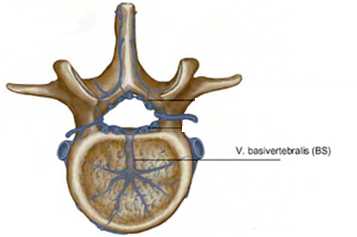

MedFriendly®


Basivertebral & Basivertebral Vein
Basivertebral means relating to the body of a
vertebra (one of many bones that surround and
protect the spine). The most common use of this
word is for the basivertebral veins. Veins are
types of blood vessels that carry blood to the
heart. The basivertebral veins are a type of vein
that comes out of the bottom part of the vertebra
through an opening known as the vertebral
foramen. They are the main veins of the vertebral
body. The vertebral veins are contained in large
winding openings in the spongy substance of the
vertebral bones. The basivertebral veins bifurcate
(split in two) to drain the vertebral body.
The basivertebral vein.
FEATURED BOOK: Neuroanatomy Through Clinical Cases
The basivertebral veins empty into a group of multiple veins (known as the venous plexus
or more specifically the anterior internal vertebral venous plexus). This group of veins
runs along the anterior part of the vertebral canal to the dura. The dura is the outermost
layer surrounding the spinal cord (and the brain). The basivertebral veins become much
larger with old age.
Basivertebral vein is also known as the vena basivertebralis. Basivertebral comes from
the Greek word "basis" meaning "foundation" and the Latin word "verto" meaning "to turn."
Put the words together and you have "foundation to turn."
"Where Medical Information is Easy to Understand"™















